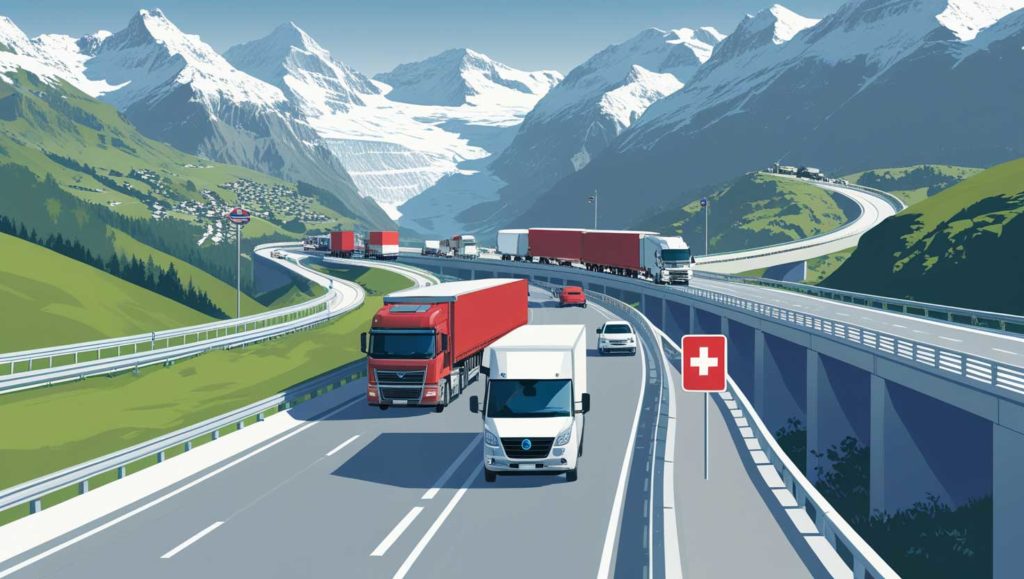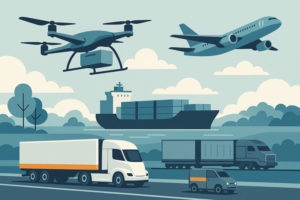Road transport in Switzerland plays a vital role in the national economy, ensuring both the mobility of people and the flow of goods across the country. Due to its strategic geographic location at the heart of Europe and its mountainous topography, Switzerland has developed a dense and efficient road network. This article explores the history of road transport in Switzerland, analyzes its economic and environmental impact, and examines the current challenges and opportunities it faces.
History of Road Transport in Switzerland
The Early Days of Road Transport
In the 19th century, before the rise of railways, transportation in Switzerland relied primarily on rudimentary roads, often impassable in winter. The Industrial Revolution increased the demand for reliable transport infrastructure to support growing industrialization. However, due to the lack of local raw materials and maritime ports, Switzerland was heavily dependent on imports, making the development of transport infrastructure crucial for its economy.
The Era of Stagecoaches and the First Carriage Roads
With the establishment of the federal state in 1848, Switzerland began constructing carriage roads across the Alps, facilitating postal stagecoach travel. These routes helped connect the country’s various regions and stimulated domestic trade.
Introduction of Motorized Vehicles
The early 20th century saw the arrival of motorized vehicles in Switzerland. The first bus line was established in 1905, followed by the launch of CarPostal’s first motor vehicle route in 1906 between Bern and Detligen. However, due to technical difficulties, horse-drawn carriages continued operating until around 1930.
Development of the Highway Network
After World War II, Switzerland made significant investments in expanding its motorway network to meet economic growth and the increasing volume of automobile traffic. Road tunnels such as the Great St. Bernard Tunnel were constructed to improve connections across the Alps.
The Swiss Road Network Today
Road Infrastructure
As of 2023, Switzerland had a road network totaling 84,868 km, including national, cantonal, and municipal roads. This dense network ensures high accessibility to all regions of the country, despite the challenges posed by the Alpine topography.
Vehicle Fleet
The number of passenger cars in Switzerland reached 4,760,948 in 2023, representing a 34% increase since 2000. This growth reflects the central role of road transport in the daily mobility of the Swiss population.
Freight Transport Modal Share
In 2023, 62% of inland freight transport was carried by road vehicles, while 38% was transported by rail. This distribution highlights the dominance of road transport in Switzerland’s freight sector.
Economic Impact of Road Transport
Contribution to the National Economy
Road transport is a pillar of the Swiss economy, facilitating both domestic and international trade. It enables the efficient distribution of goods and services, thereby supporting various economic sectors.
Employment and Industry
The road transport sector generates numerous jobs—not only for drivers but also in logistics, maintenance, and infrastructure management. It also contributes to the automotive industry and related services.
Environmental Impact of Road Transport
Greenhouse Gas Emissions
Road transport is a significant source of greenhouse gas (GHG) emissions in Switzerland. Despite technological advances aimed at reducing vehicle emissions, the sector remains a major contributor to climate change.
Air Pollution
Road vehicles emit air pollutants such as nitrogen oxides (NOx) and fine particulate matter, affecting air quality and public health—especially in densely populated urban areas.
Land Use and Habitat Fragmentation
The expansion of road infrastructure leads to extensive land use and can fragment natural habitats, negatively impacting biodiversity. Planning measures, such as ecological corridors, are being implemented to mitigate these effects.
Current Challenges for Road Transport in Switzerland
Traffic Congestion
The continuous growth of the vehicle fleet and freight volumes is causing increased congestion on certain parts of the road network, particularly near major urban centers and on trans-Alpine routes.
Energy Transition
Switzerland is committed to an energy transition aimed at reducing its dependence on fossil fuels. The road transport sector faces the challenge of adopting electric vehicles or alternative fuels to reduce its carbon footprint.
Integration with Other Modes of Transport
Effective integration of road transport with other transport modes—such as rail and inland waterways—is essential to optimize the supply chain and minimize the negative externalities of road transport.
Regulations and Public Policies
Switzerland enforces strict environmental policies, including the introduction of the Heavy Vehicle Fee (LSVA), designed to reduce nuisances from heavy freight transport.
In 2024, this fee continues to be a significant pressure point for companies, encouraging the use of cleaner vehicles and more efficient route planning. In addition, Euro VI emission standards for heavy vehicles require companies to modernize their fleets regularly.
Road Safety and Infrastructure Management
Road safety remains a top priority for both federal and cantonal authorities. In 2024, substantial investments are being made to improve the safety of tunnels, bridges, and highways. However, maintaining road safety amid growing traffic remains a constant challenge, requiring prevention campaigns, strict controls, and innovative infrastructure upgrades.
Opportunities for Road Transport in Switzerland
Despite these significant challenges, road transport in Switzerland also presents several promising opportunities, particularly in technological innovation and better multimodal integration.
Development of Electric and Hydrogen Vehicles
Switzerland is well-positioned to widely adopt electric vehicles, thanks to its stable power grid and the high share of renewable energy in its energy mix. In 2024, the electric commercial vehicle market is expanding rapidly, supported by government subsidies and attractive tax incentives. At the same time, hydrogen technology—especially for heavy-duty vehicles—is developing fast, with several pilot projects already operating on the north-south corridor, offering a real alternative to traditional fossil fuels.
Digitalization and Logistics Innovation
Digitalization is another major opportunity for road transport. The adoption of real-time tracking platforms, artificial intelligence for route optimization, and blockchain technologies for document management is already helping Swiss companies improve competitiveness. These innovations streamline administrative processes, reduce costs, and significantly increase overall sector efficiency.
Strengthening Multimodal Transport
One of the Swiss government’s core strategies for the coming years is to strengthen intermodal infrastructure. Combined rail-road transport offers an appealing alternative to reduce both the environmental and economic costs associated with purely road-based logistics. Several multimodal terminals, notably in Basel, Zurich, and Geneva, are currently undergoing significant expansion, facilitating the shift toward more sustainable logistics.
Growth of E-commerce and Urban Logistics
The rapid growth of e-commerce—accelerated by changing consumer behaviors since the pandemic—represents a major opportunity for road transport. Increasing urban logistics needs are driving the adaptation of road services through the emergence of electric light vehicles, the establishment of urban logistics hubs, and improved last-mile delivery systems. These developments are creating high-value niche markets.
| Sector Challenges | Associated Opportunities |
|---|---|
| Traffic congestion | Digital route optimization |
| Polluting emissions and climate impact | Electric and hydrogen vehicles |
| Strict environmental regulations | Tax incentives for clean vehicles |
| Expensive infrastructure maintenance and safety | Technological innovation and digitalization |
| Complex integration with rail transport | Development of multimodal transport |
| Limited access to urban centers | Growth of the urban logistics market |
Future Outlook for Road Transport in Switzerland
Road transport in Switzerland, a central pillar of the national economy, is at a turning point—facing environmental, economic, and regulatory challenges, while also being presented with major opportunities for innovation and growth. In response to climate and societal concerns, the sector is gradually shifting toward more sustainable mobility, driven by technology and stronger multimodal integration.
Swiss companies that succeed will be those that embrace new technologies (electric, hydrogen, digitalization) while optimizing their logistics processes to remain both competitive and environmentally responsible. The future of road transport in Switzerland will therefore depend on the collective ability of public and private stakeholders to work together in turning these challenges into lasting opportunities.
Striking this delicate but essential balance will position Swiss road transport as not only a resilient sector, but also an innovative and pioneering force in Europe’s ecological transition.









